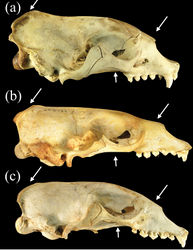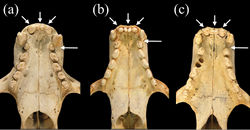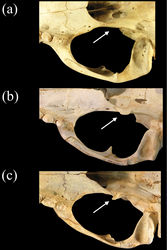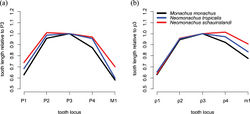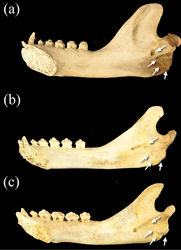Neomonachus
| Notice: | This page is derived from the original publication listed below, whose author(s) should always be credited. Further contributors may edit and improve the content of this page and, consequently, need to be credited as well (see page history). Any assessment of factual correctness requires a careful review of the original article as well as of subsequent contributions.
If you are uncertain whether your planned contribution is correct or not, we suggest that you use the associated discussion page instead of editing the page directly. This page should be cited as follows (rationale):
Citation formats to copy and paste
BibTeX: @article{Scheel2014ZooKeys409, RIS/ Endnote: TY - JOUR Wikipedia/ Citizendium: <ref name="Scheel2014ZooKeys409">{{Citation See also the citation download page at the journal. |
Ordo: Carnivora
Familia: Phocidae
Name
Neomonachus Slater & Helgen gen. n. – Wikispecies link – ZooBank link – Pensoft Profile
Type species
Monachus schauinslandi Matschie, 1905 (endemic to the Hawaiian Islands).
Other included species
A second species, Monachus tropicalis (Gray, 1850) (endemic to the Caribbean region, recently extinct). We note here, as an aside, that an earlier specific epithet, antillarum Gray, 1849, has often been included in the synonymy of tropicalis, where it is identified either as a partial synonym (e.g., Allen 1880[1]: 708, 1887[2]: 3, Adam 2004[3]: 1) or a nomen nudum (Wozencraft 2005[4]: 598), or simply listed as a synonym without comment (Wozencraft 1993[5]: 331, Berta and Churchill 2012[6]: 219). However, Gray (1849)[7] in fact used this name to describe Cystophora antillarum, based on a juvenile male specimen of a Hooded seal, supposedly from Jamaica (Allen 1880[1], Gill 1866[8]), and the name is not a nomen nudum. It is clear that the skin of the Caribbean monk seal that Gray later used to describe Phoca tropicalis (Gray 1850[9]), also from Jamaica, was not part of his hypodigm of antillarum, to which he explicitly attributed a single Cystophora skin and skull (Gray 1849[7], 1850[9]; Allen 1887[2]:postscript). Thus the name antillarum does not correctly belong in the synonymy of Neomonachus tropicalis (it is neither a partial synonym nor a nomen nudum). It is instead simply a junior synonym for the Hooded seal, Cystophora cristata (which occasionally occurs as a Caribbean vagrant: Mignucci-Giannoni and Odell 2001[10], Ward et al. 2013[11]). The only additional name that correctly belongs in the technical synonymy of tropicalis is the junior synonym [Phoca] wilkianus (Gosse 1851[12]), described from the Pedro Keys, south coast of Jamaica, soon after Gray’s (1850)[9] description of tropicalis (see Allen 1880[1]).
Etymology
The new generic name combines the Greek Neo- (new), with Monachus, the genus name previously used for all monk seals. The name references both the recognition of a new genus within the monk seals and its New World (Western Hemisphere) distribution.
Morphological diagnosis
Species of Neomonachus can be distinguished from Monachus in their smaller average body size and in lacking a white ventral patch on the pelage (in both adults and young) (Adam 2004[3]). Species of Neomonachus possess a narrower and more gracile skull than Monachus, with relatively poorly developed sagittal and occipital crests in even the largest males (Figure 5). The rostrum is low and elongate with a conspicuous diastema between C1 and the first upper premolar (P1). In Monachus, the diastema is lacking and the anterior edge of P1 may be positioned medially to the canine (Figures 5, 6). The antorbital process of the maxilla (Figure 7) is present in Monachus but is extremely reduced or absent in Neomonachus (King 1956[13]). The nasals are relatively narrow and posteriorly extended in Neomonachus compared to Monachus (Figure 7). The zygomatic arch is dorso-ventrally shallow and the jugal portion lacks a well-developed masseteric margin ventrally or orbital margin superiorly (the zygomatic arch is robust and both margins are well-defined in Monachus) (Figure 5). The pterygoid shows a conspicuous, laterally flared hamular process in Neomonachus (King 1956[13]) that may be spatulate (Neomonachus schauinslandi) or hook-like (Neomonachus tropicalis); the process is absent or small and medially inflected in Monachus (Figure 8). In ventral view, the morphology of the petromastoid (petrosal-mastoid) complex in relation to the auditory bulla in Neomonachus is diagnostic in comparison to Monachus. King (1966)[14] noted that having the petrosal visible within the posterior lacerate foramen was a feature that united Monachus and the phocines, although Ray (1976b)[15] pointed out that it is difficult to distinguish the boundaries of the petrosal and mastoid (petromastoid complex) in the posterior lacerate foramen and that this character was far more variable within lobodontines than King had estimated. He argued that a better standard for delineating this character state uniting Mirounga and the lobodontines is a bulla in near contact or complete contact with the exoccipital. We agree with Ray’s assessment, but we note that the configuration of the petromastoid complex and bulla with respect to the posterior lacerate foramen is more complex within “Monachus” (i.e. sensu lato) than has been previously described. In particular, the petromastoid of Monachus monachus is clearly ventrally inflated, such that it protrudes below the rim of the posterior lacerate foramen, forming its entire lateral border (Figure 9a). Furthermore, the ventral expansion of the petromastoid almost completely excludes the flat posterior edge of the bulla from the anterior margin of the posterior lacerate foramen. This morphology, which is also present in the fossil taxon Pliophoca, has been proposed as synapormorphic for Monachini (Amson and de Muizon 2013[16]). However, in Neomonachus, the tapering posterior margin of the bulla lies completely ventral to the petromastoid, the posterior border of which is visible within the neurocranium through the posterior lacerate foramen (Figure 9: b and c). Ray also noted that the posterior carotid foramen opens in full view in Monachus (sensu lato) but is partially concealed on the medial bulla wall in phocines (Ray 1976b[15]). Our observations show that, for Neomonachus, the posterior carotid canal opens directly posteriorly, with a flattened dorsal roof formed by excavation of the caudal entotympanic (Figure 9). In Monachus, the canal opens postero-ventrally due to a more complete, ring-like opening. These character-state differences are clearly developed even in juvenile individuals, indicating that they are not the outcome of ontogenetic variation. The upper incisor arcade of Neomonachus is sublinear, while that of Monachus appears slightly parabolic due to a more posteriorly set I3 (King 1956[13]; Figure 6). The upper post-canine toothrow of Neomonachus is arranged more linearly than in Monachus, where the teeth are obliquely oriented. In specimens of Neomonachus with unworn dentitions, both upper and lower premolars and first molar possess low, blunt central cusps and two posterior accessory cusps, as compared with a high, pointed central cusp and a single posterior accessory cusp for Monachus. In both Neomonachus and Monachus, p3 is the largest of the lower teeth. However, in Monachus, lower post-canine tooth size decreases in the order p3, p2, p4, m1, p1, while the lower teeth of Neomonachus decrease in the order p3, p4, p2, m1, p1; and p4 may be larger than p3 in some individuals (Figure 10). The mandible of Neomonachus is long and slender compared with that of Monachus, and the coronoid process is lower and less broad antero-posteriorly (King 1956[13]; Figure 11). The mandibular foramen is anteriorly displaced and lies at the termination of a shallow, antero-ventrally oriented sulcus that begins below the level of the mandibular notch. In Monachus, the foramen opens directly at this level. The insertion of the pterygoid muscles is relatively undefined in Neomonachus as compared to the markedly expanded area evident in Monachus (Figure 11).
Original Description
- Scheel, D; Slater, G; Kolokotronis, S; Potter, C; Rotstein, D; Tsangaras, K; Greenwood, A; Helgen, K; 2014: Biogeography and taxonomy of extinct and endangered monk seals illuminated by ancient DNA and skull morphology ZooKeys, 409: 1-33. doi
Other References
- ↑ 1.0 1.1 1.2 Allen J (1880) History of North American pinnipeds: a monograph of the walruses, sea-lions, sea-bears, and seals of North America. Miscellaneous Publications of the U.S. Geological and Geographical Survey of the Territories 12: 1-785.
- ↑ 2.0 2.1 Allen J (1887) The West Indian seal (Monachus tropicalis Gray). Bulletin of the American Museum of Natural History 2: 1-33.
- ↑ 3.0 3.1 Adam P (2004) Monachus tropicalis. Mammalian Species 747: 1-9. doi: 10.1644/747
- ↑ Wozencraft W (2005) Order Carnivora. In: Wilson D Reeder D (Eds) Mammal Species of the World: A Taxonomic and Geographic Reference, third edition. Johns Hopkins University Press, Baltimore, Maryland, USA, 532-628.
- ↑ Wozencraft W (1993) Order Carnivora. In: Wilson D Reeder D (Eds) Mammal Species of the World: A Taxonomic and Geographic Reference, second edition. Smithsonian Institution Press, Washington, D.C., USA, 279-348.
- ↑ Berta A, Churchill M (2012) Pinniped taxonomy: review of currently recognized species and subspecies, and evidence used for their description. Mammal Review 42: 207-234. doi: 10.1111/j.1365-2907.2011.00193.x
- ↑ 7.0 7.1 Gray J (1849) On the variation of the teeth of the crested seal, Cystophora cristata, and on a new species of the genus from the West Indies. Proceedings of the Zoological Society of London 1849: 91-93.
- ↑ Gill T (1866) Prodrome of a monograph of the Pinnipedes. Proceedings of the Essex Institute 5: 3-13.
- ↑ 9.0 9.1 9.2 Gray J (1850) Catalogue of the Specimens of the Mammalia in the Collections of the British Museum. Part 2. Seals. British Museum of Natural History, London.
- ↑ Mignucci-Giannoni A, Odell D (2001) Tropical and subtropical records of hooded seals (Cystophora cristata) dispel the myth of extant Caribbean monk seals (Monachus tropicalis). Bulletin of Marine Science 68: 47-58.
- ↑ Ward N, Bogomolni A, Potter C (2013) A Stranding Guide to the Marine Mammals of the Wider Caribbean Region: An Introductory Field Guide for Stranding Responders. Gecko Productions, Wood’s Hole, MA, USA.
- ↑ Gosse P (1851) A Naturalist’s Sojourn in Jamaica. Longman, Brown, Green, and Longmans, London.
- ↑ 13.0 13.1 13.2 13.3 King J (1956) The monk seals (genus Monachus). Bulletin of the British Museum (Natural History) 3: 203-256. doi: 10.1111/j.1469-7998.1966.tb02958.x
- ↑ King J (1966) Relationships of the hooded and elephant seals (genera Cystophora and Mirounga). Journal of Zoology (London) 148: 385-398.
- ↑ 15.0 15.1 Ray C (1976b) Phoca wymani and other Tertiary seals (Mammalia: Phocidae) described from the eastern seaboard of North America. Smithsonian Contributions to Paleobiology 28: 1–36. doi: 10.5479/si.00810266.28.1
- ↑ Amson E, de Muizon C (2013) A new durophagous phocid (Mammalia: Carnivora) from the Late Neogene of Peru and considerations on monachine seals phylogeny. Journal of Systematic Paleontology. doi: 10.1080/14772019.2013.799610
Images
|
